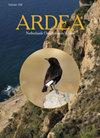Importance of Algarrobo Trees Prosopis flexuosa for Territory Establishment of Three Seed-Eating Passerine Species in the Central Monte Desert
IF 0.8
4区 生物学
Q3 ORNITHOLOGY
引用次数: 0
Abstract
In the central Monte desert in Argentina, feeding site selection by seed-eating birds and their high abundance associated with the presence of trees (particularly Algarrobos Prosopis flexuosa) are well known patterns during the breeding season, but these associations disappear during autumn and winter. In order to understand habitat selection by these bird species, we assessed the importance of Algarrobos during the defence and establishment of breeding territories in the open Algarrobo woodland of the central Monte desert for the three most common resident seed-eating birds: Ringed Warbling-finch Microspingus torquatus, Many-coloured Chaco Finch Saltatricula multicolor and Rufous-collared Sparrow Zonotrichia capensis. Despite some ecological differences between the species (e.g. nest site selection, feeding behaviour) all of them selected Algarrobos as song posts. Height, density and spatial configuration of these trees were features associated with the selection of territories. The patterns of selection we found at previously unexplored spatial scales (territory and within-territory) and associated with territorial defence, provided plausible explanations to seasonal shifts in the space use reported for central Monte desert seed-eating birds and highlight the close link between central Monte desert avifauna and Algarrobos. As in many arid regions, tall scattered trees are keystone features of the central Monte desert and management plans should be implemented in order to stop the current degradation and loss of these arid woodlands.弯曲藻对中蒙特沙漠建立三种食籽雀形目的重要意义
在阿根廷的蒙特沙漠中部,食种鸟类的觅食地点选择及其与树木(特别是Algarrobos Prosopis flexuosa)存在相关的高丰度是繁殖季节的众所周知的模式,但这些关联在秋冬季节消失了。为了了解这些鸟类的栖息地选择,我们评估了Algarobos在蒙特沙漠中部开放的Algarobo林地防御和建立繁殖区期间对三种最常见的常驻食种鸟类的重要性:环纹燕雀Microspingus torquatus,五颜六色的Chaco Finch Saltatricula和Rufus领麻雀Zonotrichia capensis。尽管物种之间存在一些生态差异(如巢址选择、觅食行为),但所有物种都选择了Algarrobos作为歌柱。这些树木的高度、密度和空间配置是与领土选择相关的特征。我们在以前未探索的空间尺度(领土和领土内)上发现的与领土防御相关的选择模式,为据报道的蒙特沙漠中部食籽鸟类空间使用的季节性变化提供了合理的解释,并强调了蒙特沙漠中部鸟类群和阿尔加罗博斯之间的密切联系。与许多干旱地区一样,高大分散的树木是蒙特沙漠中部的主要特征,应该实施管理计划,以阻止这些干旱林地目前的退化和损失。
本文章由计算机程序翻译,如有差异,请以英文原文为准。
求助全文
约1分钟内获得全文
求助全文
来源期刊

Ardea
生物-鸟类学
CiteScore
2.10
自引率
0.00%
发文量
49
审稿时长
>12 weeks
期刊介绍:
Ardea is the scientific journal of the Netherlands Ornithologists'' Union, and is published since 1912. The journal welcomes manuscripts reporting significant new findings in ornithology, in particular those covering the ecology, life history, and evolution of birds, and including sound descriptive work. Ardea publishes Original research papers, Short notes and Book reviews. In addition to the regular three issues per year, Ardea publishes specials that contain conference or workshop proceedings (produced on request).
 求助内容:
求助内容: 应助结果提醒方式:
应助结果提醒方式:


